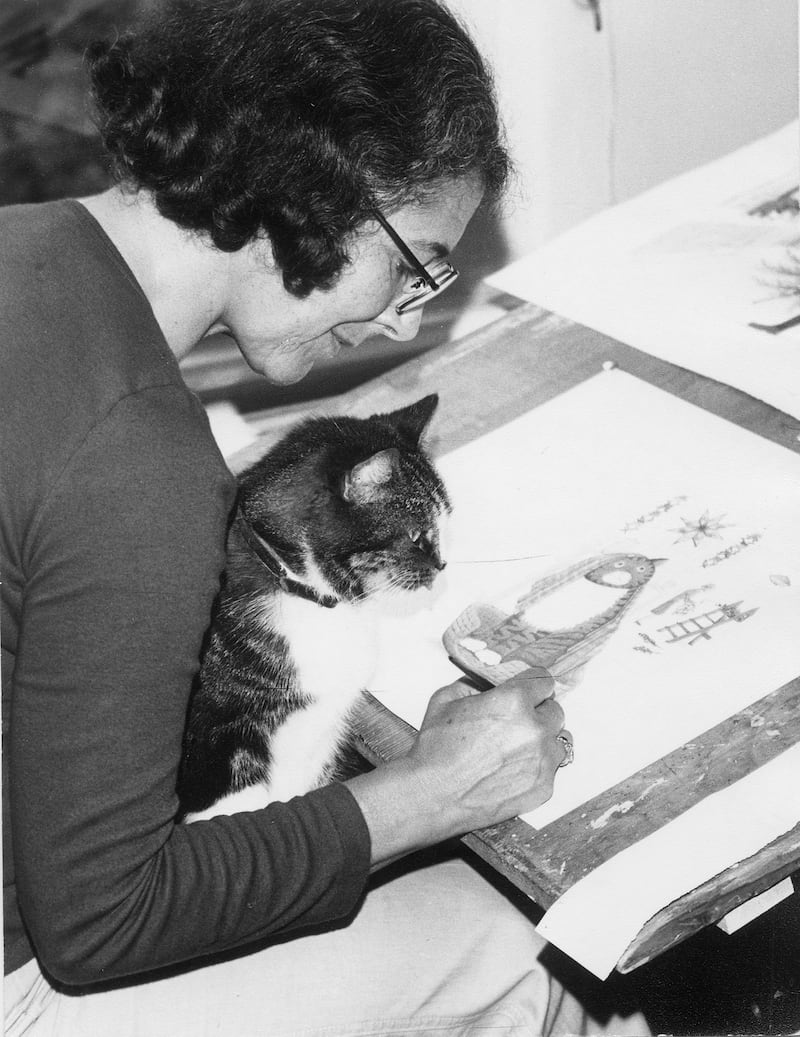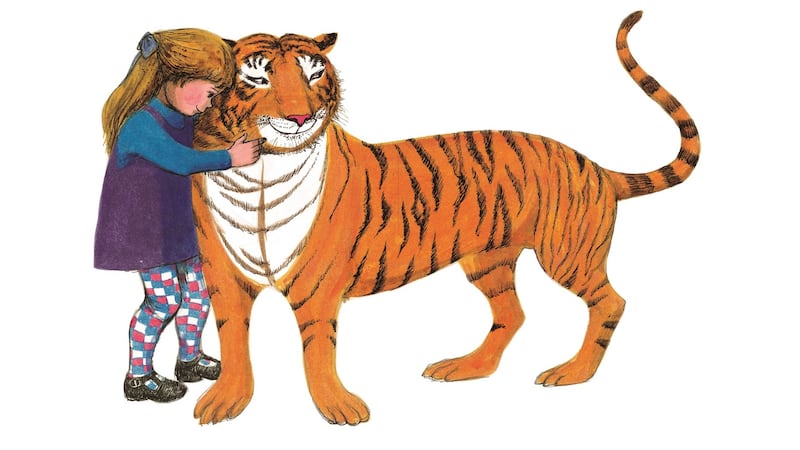Judith Kerr opens the door of her home in the salubrious south London suburbs and a flash of chartreuse pops behind her diminutive 93-year-old frame. Immaculately clad in a black twinset and pearls, she leads me down the hallway to where the colour sings, in the kitchen where her most famous picture-book, The Tiger Who Came to Tea, is set.
The room is preserved in its 1968 immortalisation, although there is no tiger stretched out across the countertop, “drinking all the water in the tap”. There is, however, a white beast of a cat skulking around.
This is Kalinka, the ninth cat in the Kerr household, and the last in a long lineage of felines who have provided inspiration for Kerr’s other well-known creation, the ornery tabby Mog, who has been entertaining young readers with her adventures since 1970.

“Everything I have done in my work is autobiographical in one way or another,” Kerr says, when describing her remarkable 50-year career in children’s literature. “Taking ideas from cats I’ve known, or my childhood, or something I came up with to entertain my children.”
She winces, as if apologising for her lack of imagination, but Kerr – a Jewish refugee from wartime Germany – has led an extraordinary life, and even the sanguine domesticity of her picture-books pay testament to a personality shaped by the extreme circumstances of her childhood.
Nazi watchlist
Kerr was nine years old when her family fled Berlin, after her father’s name appeared on a Nazi watchlist. He was a theatre reviewer, writer and outspoken critic of the regime that was about to come to power. A man “who knew what was coming long before it happened”, he fled the country immediately.
On the eve of Hitler’s election as führer, Kerr’s mother set off to join him, smuggling Judith and her younger brother on a milk train across the Swiss border to Zurich.
Kerr left behind a favourite stuffed toy, the pink rabbit that provided the title for her novel about the second World War, When Hitler Stole Pink Rabbit, which was published in 1971 and became an instant classic, both in England and in her native Germany.
I truly always saw it as a great adventure
“No one knew how to tell children what had happened,” she says when explaining its success and continued popularity, “and because nothing terrible happened to me it is an easy introduction to what happened in Germany at the time.”
When Hitler Stole Pink Rabbit captures the experience of a young refugee with the optimism only a childhood survivor could muster.
“I truly always saw it as a great adventure,” she says. “The places we went, the people we met, were so interesting and exciting. It gave us huge confidence, to come to a country, as we did in France, where we didn’t know what anyone was talking about, and we thought we would never be able to learn the language. But when you are 10, it turns out it’s not actually very difficult.”
When Hitler Stole Pink Rabbit ends as the fictional family set off for England, "excited and full of hope". By the time the second World War broke out, the real Kerrs had also made their way to London.
Kerr and her brother adapted easily to the new language and culture, but their parents found it difficult to settle among the English intelligentsia, and lived in constant fear of a German invasion; they carried suicide pills “just in case”.
Traumatic
“When you are a child,” Kerr says when contrasting her experience of events to her parents’ more traumatic one, “you just believe that everything will be all right.
“You think your parents know everything and the world is as you see it. But then you grow up and you are looking after your parents in some way, and it was then I began to realise what they had been through.”
I tried to write a novel, something from my head, and I gave up after 18 months. It nearly killed me
As a consequence, the two autobiographical novels that followed When Hitler Stole Pink Rabbit "are more grown-up books", as the childish narrator reaches an awareness of the world around her.
“After that I thought I was a novelist – a proper one, who would write for adults – but I tried to write a novel, something from my head, and I gave up after 18 months. It nearly killed me.”
Kerr never set out to be a writer. “I had no particular interest in writing when I was a child. I was always too busy drawing.”
She studied art at Central School of Arts and Crafts and had ambitions to be a painter, but her husband, the writer Nigel Kneale, got her a part-time job as a script-reader with the BBC to "help pay the bills". When they started a family, she stayed at home with the children, and it was this experience that informed her first foray into picture-book making.
“I used to tell my children bedtime stories and there was one they liked – there was actually only one they ever liked; they were very critical of the others. It was about a tiger who called to the house.

“When you are at home all day it can be terribly boring, and a tiger ringing the doorbell was about the most exciting thing I could imagine at the time.
“When the children went to school, and I was trying to decide what I should do, I thought I would try and make the story into a picture-book. I had this idea that I would like to write a book with bright pictures and simple words that children might actually want to read.
“By this stage [1968] TV and radio were everywhere, and I think people were very conscious that children could get stories without learning to read, and that it might be a good idea if you gave them a book that would make it worth their while.”
Experimenting
Kerr wrote The Tiger Who Came to Tea just as she told it to her children, but when she started drawing, "I really didn't know where to begin. It was so very different from painting. I was sort of experimenting a bit with watercolours, when I met someone I had been at art school with. He was at this stage a cartoonist with Punch, and he had drawn a particular picture and I asked him about it.
“He was using indelible inks, and he showed me how you could layer them up, so I bought some and that is what I still use when I am drawing, with lots of crayon on top.”
I will never forget the joy of seeing red and yellow and pink paint, clothes, after so many years when there was nothing more than the essentials
With its bright colour palette, The Tiger Who Came to Tea immediately conjures up the vivid visual landscape of the 1960s, which Kerr remembers as a direct cultural response to the war.
“All through the war there was no colour at all. The only paint you could get was grey or black; the stuff they use on battleships, no colour at all. It was marvellous seeing colour again [when the war was over] and being able to use it. I will never forget the joy of seeing red and yellow and pink paint, clothes, after so many years when there was nothing more than the essentials.”
Kerr’s first cat, Mog, also came about because of peacetime. “I desperately wanted a cat when I was a child, but because we were always wandering around from place to place it was never possible. As soon as we got this house [where Kerr has lived for almost 60 years], we got a cat and we called it Mog, and I was totally fascinated by things she did.”
Christmas trees
Mog’s adventures became the inspiration for Kerr’s next books. When Mog died, those that came after exerted a similar hold on her imagination. “There was the one who was terrified of heights but would climb trees anyway. Another who was afraid of Christmas trees.”
I get truly miserable if I don't have my pens
After nine feline muses, Kerr put Mog to rest in 2002. “At that stage I was in my early 80s and I was thinking about death a lot, and I wanted to say that we don’t totally lose people when they die; I still talk to my father, to my husband, nearly every day.”
Kerr still works every day too, at an easel in the window of the top floor of her house. “Oh, I have to keep drawing. I get truly miserable if I don’t have my pens.”
It is difficult to imagine Kerr without her broad smile and trademark optimism.
“Or, to put it another way, I don’t know who I am.”
Judith Kerr will be in conversation at the Pavilion Theatre, Dún Laoghaire on March 25th as part of the Mountains to Sea Literary Festival
















